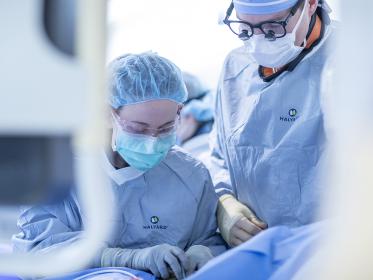Overview
An aortic aneurysm is an abnormal widening or ballooning of a portion of an artery due to weakness in the wall of the blood vessel. There are two types:
- Abdominal aortic aneurysm
- Thoracic aortic aneurysm
Most develop in the blood vessel that passes though the abdomen. These are known as abdominal artery aneurysms. But approximately 25 percent develop where it passes through the aorta, the main blood vessel in the chest.
We call these thoracic aneurysms. They can grow and rupture, causing massive internal bleeding and death, if not treated.
Risk Factors for Thoracic Aortic Aneurysm
The most common cause of a thoracic aortic aneurysm is hardening of the arteries (atherosclerosis). This condition is more common in:
- Men and women with a family history of aortic aneurysms
- Individuals 60 years of age or older
- Tobacco use
- History of heart or peripheral artery disease
- High blood pressure
- Chronic lung disease
Treatment of Thoracic Aortic Aneurysm
In the event that surgical treatment is necessary, patients may have two options for treating the aneurysms:
- Open surgical repair
- Endovascular stent graft repair (minimally invasive procedure)
The minimally invasive procedure uses endografts, a hollow, fabric-covered tube that takes the pressure off the aorta. This lets blood pass through it without pushing on the weakened, bulging artery.
“This procedure has many advantages for the patient over the traditional open surgery,” according to Vascular Surgeon Michael Freeman, MD. “The size of the incision is much smaller, and you have less of a risk of infection. There also is less recovery time and less blood loss.”
Your surgeon will determine the type of repair needed based on location and complexity of the aneurysm.





